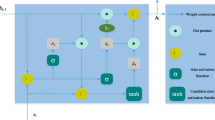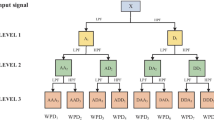Abstract
Because most of runoff time series with limited amount of data reveal inherently nonlinear and stochastic characteristics and tend to show chaotic behavior, strategies based on chaotic analysis are popular methods to analyze them from real systems in nonlinear dynamics. Only one kind of predicted method for yearly rainfall-runoff forecasting cannot achieve perfect performance. Thus, a mixture strategy denoted by WT-PSR-GA-NN, which is composed of wavelet transform (WT), phase space reconstruction (PSR), neural network (NN) and genetic algorithm (GA), is presented in this paper. In the WT-PSR-GA-NN framework, the process to deal with time series gathered from Liujiang River runoff data is given as follows: (1) the runoff time series was first decomposed into low-frequency and high-frequency sub-series by wavelet transformation; (2) the two sub-series were separately and independently reconstructed into phase spaces; (3) the transformed time series in the reconstructed phase spaces were modeled by neural network, which is trained by genetic algorithm to avoid trapping into local minima; (4) the predicted results in low-frequency parts were combined with the ones of high-frequency parts, and reconstructed with wavelet inverse transformation, to form the future behavior of the runoff. Experiments show that WT-PSR-GA-NN is effective and its forecasting results are high in accuracy not only for the short-term yearly hydrological time series but also for the long-term one. The comparison results revealed that the overall forecasting performance of WT-PSR-GA-NN proposed by us is superior to other popularity methods for all the test cases. We can conclude that WT-PSR-GA-NN can not only increase the forecasted accuracy, but also its own competitiveness in efficiency, effectiveness and robustness.
Access this article
Rent this article via DeepDyve


















Similar content being viewed by others
Explore related subjects
Discover the latest articles, news and stories from top researchers in related subjects.References
Abghari H, Ahmadi H, Besharat S (2012) Prediction of daily pan evaporation using wavelet neural networks. Water Resour Manag 26:3639–3652
Chen YH, Chang FJ (2009) Evolutionary artificial neural networks for hydrological systems forecasting. J Hydrol 367:125–137
Ding J, Wang WS, ZHAO YL (2003a) Characteristics of daily flow variation in the Yangtze River, optimum determination of delay time for reconstruction of a phase space. Adv Water Sci 14(4):407–411
Ding J, Wang WS, ZHAO YL (2003b) Characteristics of daily flow variation in the Yangtze River, optimum determination of embedding dimension for reconstruction of a phase space. Adv Water Sci 14(4):412–416
Ding H, Yang J (2012) Wavelet transformation combined neural network based on genetic algorithm for runoff prediction. J Guangxi Univ (Nat Sci Ed) 37(3):580–587
Dong WY, Zhang WS, Yu RG (2011) Convergence and runtime analysis of ITO algorithm for one class of combinatorial optimization. Jisuanji Xuebao (Chin J Comput) 34(4):636–646
Evsukoff AG, Cataldi M, Lima BSLP (2012) A multi-model approach for long-term runoff modeling using rainfall forecasts. Expert Syst Appl 39:4938–4946
Fei YJ, Xu LL, Du PJ (2011) Analysis of characteristics of time–frequency correlations between runoff, tidal range and salinity in the Changjiang Estuary. Acta Oceanol Sinica 30(5):84–93
Huang W, Ding LX (2012) The shortest path problem on a fuzzy time-dependent network. IEEE Trans Commun 60(11):3376–3385
Jiang AH, Huang XC, Zhang ZH (2010) Mutual information algorithms. Mech Syst Signal Process 24:2947–2960
Kim HS, Lee KH, Kyoung MS et al (2009) Measuring nonlinear dependence in hydrologic time series. Stoch Environ Res Risk Assess 23(7):907–916
Long JQ, Lan FC, Chen JQ (2009) Mechanical properties prediction of the mechanical clinching joints based on genetic algorithm and BP neural network. Chin J Mech Eng 22(1):36–41
Maheswaran R, Khosa R (2012) Wavelet–Volterra coupled model for monthly stream flow forecasting. J Hydrol 450–451:320–335
Millán H, Rodríguez J, Ghanbarian-Alavijeh B, Biondi R, Llerena G (2011) Temporal complexity of daily precipitation records from different atmospheric environments: Chaotic and Lévy stable parameters. Atmos Res 101:879–892
Minns AW, Hall MJ (1996) Artificial neural networks as rainfall-runoff models. Hydrol Sci J 41(3):399–417
Nourani V, Kis Ö, Komasi M (2011) Two hybrid artificial intelligence approaches for modeling rainfall-runoff process. J Hydrol 402:41–59
Partal T (2012) Wavelet analysis and multi-scale characteristics of the runoff and precipitation series of the Aegean region (Turkey). Int J Climatol 32:108–120
Peng JT, Peng SL, Hu Y (2012) Partial least squares and random sample consensus in outlier detection. Anal Chim Acta 719:24–29
Rosenstein MT, Collins JJ, Luca CJD (1993) A practical method for calculating largest Lyapunov exponents from small data sets. Phys D 65:117–134
Sang YF (2012) A practical guide to discrete wavelet decomposition of hydrologic time series. Water Resour Manag 26:3345–3365
Sedki A, Ouazar D, Mazoudi E et al (2009) Evolving neural network using real coded genetic algorithm for daily rainfall-runoff forecasting. Expert Syst Appl 36(3):4523–4527
Sivakumar B, Berndtsson R, Persson M (2001) Monthly runoff prediction using phase space reconstruction. Hydrol Sci J 46(3):377–387
Tokar AS, Johnson PA (1999) Rainfall-runoff modeling using artificial neural networks. J Hydrol Eng 4(3):232–239
van Houwelingen HC, Sauerbrei W (2013) Cross-validation, shrinkage and variable selection in linear regression revisited. Open J Stat 3:79–102
Wang WS, Ding J (2003) Wavelet network model and its application to the prediction of hydrology. Nat Sci 1(1):67–71
Wang XC, Wang SC, Sun RJ (2010) Design of artificial neural networks using a genetic algorithm to predict saturates of vacuum gas oil. Petrol Sci 7:118–122
Wu JS, Jin L (2009) Study on the meteorological prediction model using the learning algorithm of neural network based on pso algorithms. J Trop Meteorol 16(1):83–88
Wu CL, Chau KW (2010) Data-driven models for monthly stream flow time series prediction. Eng Appl Artif Intell 23:1350–1367
Xu JH, Chen YN, Li WH (2008) Long-term trend and fractal of annual runoff process in mainstream of Tarim River Chin. Chin Geogr Sci 18(1):077–084
Yu GR, Yang JR, Xia ZQ (2011) The prediction model of chaotic series based on support vector machine and its application to runoff. Adv Mater Res 255:3594–3599
Acknowledgments
The authors would like to extend sincere gratitude to the editor and anonymous re-viewers’ comments for suggestions of improving this paper. This paper was supported by the National Natural Science Foundation of China under Grant No. 61170305, the National Natural Science Foundation of China under Grant No. 11161029, the National Natural Science Foundation of China under Grant No. 60873114, the Foundation of Guangxi education office under Grant No. LX2014497, and the Foundation of Liuzhou Guangxi city science and technology bureau under Grant No. 2014J020401, the Guangxi Natural Science Foundation under Grant No. 2014GXNSFAA118027, and the Foundation of science research and technology development of Laibin Guangxi city.
Author information
Authors and Affiliations
Corresponding author
Additional information
Communicated by V. Loia.
Rights and permissions
About this article
Cite this article
Ding, H., Dong, W. Chaotic feature analysis and forecasting of Liujiang River runoff. Soft Comput 20, 2595–2609 (2016). https://doi.org/10.1007/s00500-015-1661-1
Published:
Issue Date:
DOI: https://doi.org/10.1007/s00500-015-1661-1




